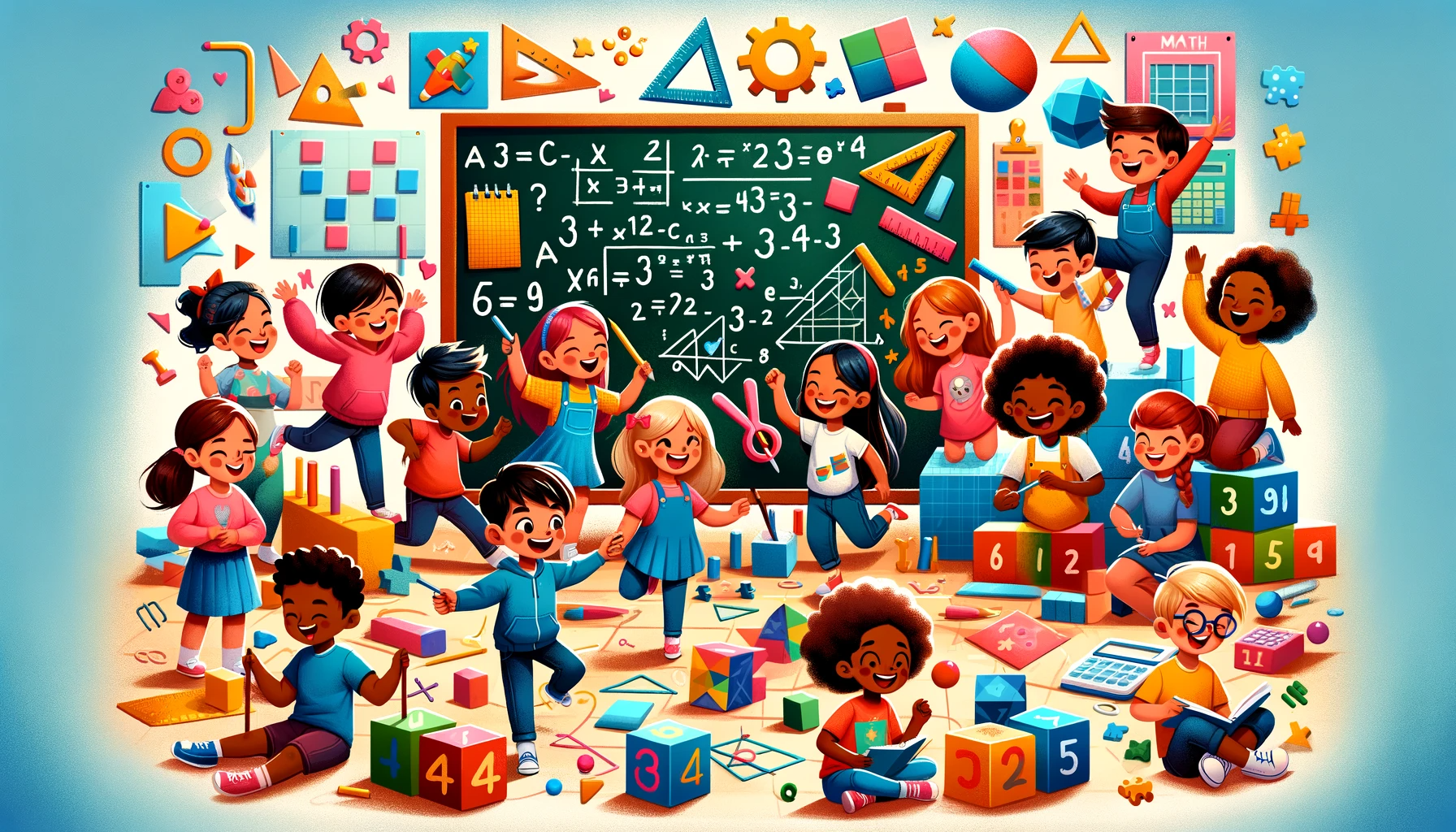Math trivia questions for kids offer a captivating blend of challenge and entertainment, turning the sometimes daunting world of mathematics into an exciting adventure.
From the basic whole numbers to the complexities of the Fibonacci sequence, math trivia encompasses a wide range of topics that intrigue young minds. Whether it’s uncovering the only even prime number, exploring the only number whose letters are in alphabetical order, or deciphering the mysteries of square roots and natural numbers, these trivia questions not only enhance problem-solving skills but also reveal interesting facts about mathematics that resonate with kids.
Math trivia questions serve not just as a great way to learn, but also as a fun activity for kids. They combine learning with play, making them a popular choice for educational games, classroom activities, and even family trivia nights.
The correct answers, often accompanied by interesting facts, add to the excitement and joy of learning. By framing math problems as fun trivia questions, we transform the learning experience, making it both engaging and effective for young learners.
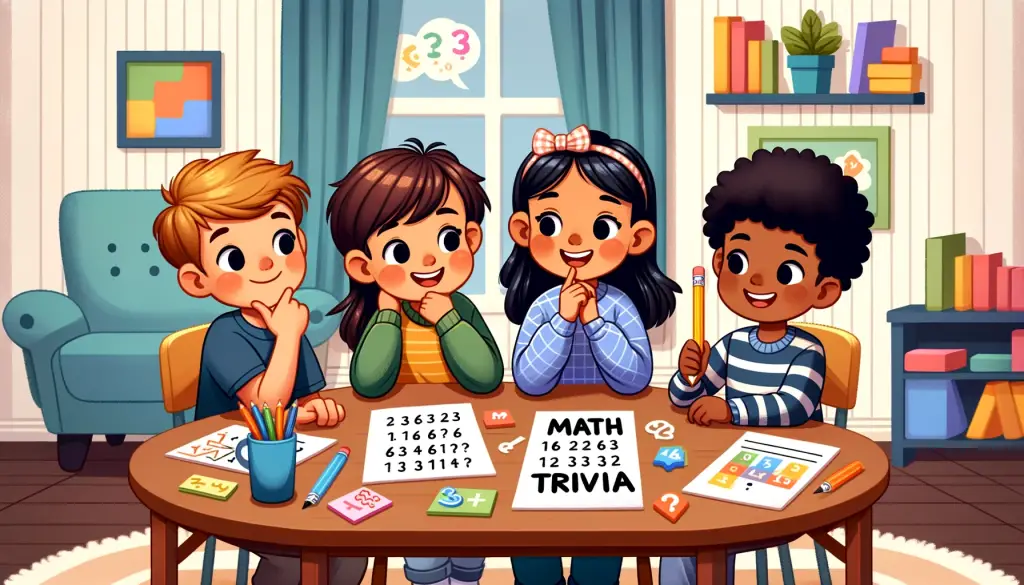
Easy Math Trivia for Young Kids
Engaging young minds in the fascinating world of mathematics can be both fun and educational. Easy math trivia for young kids is a fantastic way to introduce them to basic math concepts in an enjoyable way and for parents – spend more time with your kids. This section focuses on simple arithmetic, counting, and basic shapes, which are fundamental building blocks in a child’s mathematical journey.
- Counting and Whole Numbers:
- Question: “If you have 2 apples and get 3 more, how many apples do you have in total?”
- Answer: 5 apples
This question not only tests addition skills but also reinforces the concept of whole numbers in a real-world context.
- Simple Geometry:
- Question: “How many sides does a triangle have?”
- Answer: 3 sides
Introducing basic shapes like triangles helps kids understand the concept of sides and angles in a simple, relatable manner.
- Addition and Subtraction Fun:
- Question: “What is 10 minus 4?”
- Answer: 6
Basic subtraction questions like this are a great way to develop early arithmetic skills.
- Identifying Shapes:
- Question: “What shape has four equal sides and four right angles?”
- Answer: A square
This question is not only about recognizing shapes but also introduces the idea of equal sides and right angles, key concepts in geometry.
- Number Patterns:
- Question: “What comes next in this pattern? 1, 2, 3, 4, _?”
- Answer: 5
Simple number patterns are an interesting way to encourage logical thinking and number sequence recognition.
- Fun with Math Concepts:
- Question: “If you have one candy bar and your friend gives you another, how many candy bars do you have?”
- Answer: 2 candy bars
This question uses a relatable scenario to make addition tangible and fun.
- Exploring the World of Numbers:
- Question: “What is the only even prime number?”
- Answer: 2
This trivia question introduces the concept of prime numbers in an accessible way.
Through these easy math trivia questions, kids not only learn fundamental math concepts but also develop critical thinking skills. Such questions blend educational content with a fun approach. This approach to math trivia ensures that kids are not just passively receiving information but actively engaging with and enjoying the learning process.
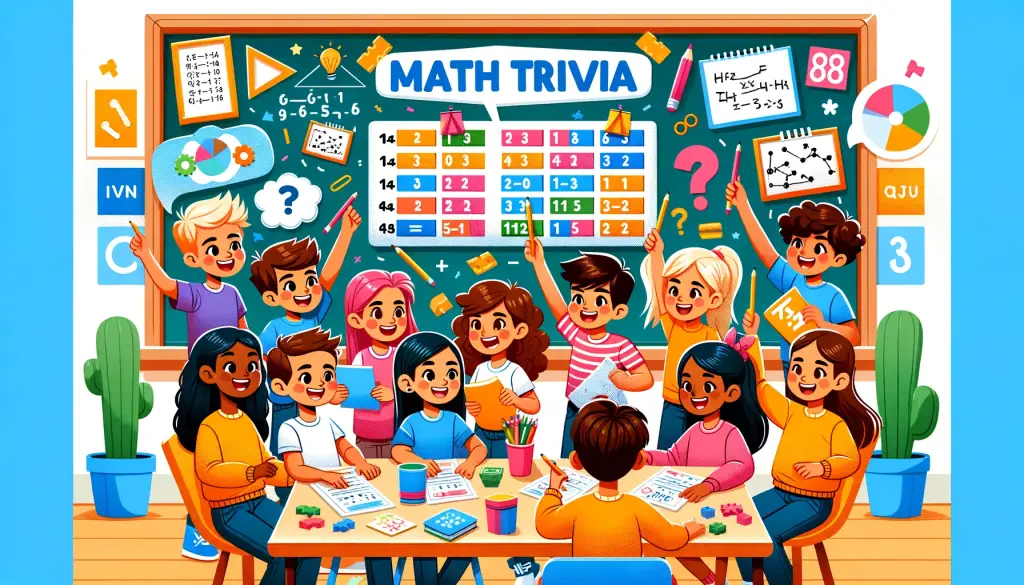
Fun Facts and Puzzles in Math
Diving into the world of math can be a fascinating adventure, especially when it’s filled with fun facts and puzzles. This section covers topics like palindromes, the Fibonacci sequence, and unique math terms that add a twist of excitement to mathematical learning.
- The Intrigue of Palindromes:
- Fact: A palindrome is a number that reads the same forwards and backwards, like 121 or 12321.
- Puzzle: “Can you think of a three-digit palindrome?”
Palindromes are an interesting way to explore numbers and can spark curiosity in children about number patterns.
- Fibonacci Sequence Fascination:
- Fact: The Fibonacci sequence is a series of numbers where each number is the sum of the two preceding ones, often starting with 0 and 1.
- Puzzle: “What are the first five numbers in the Fibonacci sequence?”
This sequence not only unveils a pattern in numbers but also connects to various phenomena in the natural world, providing an interesting way to link math to everyday life.
- Exploring Unique Math Terms:
- Fact: An ‘isosceles triangle’ is a triangle with two sides of equal length.
- Puzzle: “Can you draw or identify an isosceles triangle?”
Introducing such terms helps children understand different shapes and properties in geometry.
- Number Fun with Roman Numerals:
- Fact: Roman numerals are a numeral system of ancient Rome based on letters of the alphabet, like I for 1, V for 5, and X for 10.
- Puzzle: “What number is represented by the Roman numeral ‘IV’?”
Learning about Roman numerals is a fun way to explore historical number systems and understand how they are used in various contexts, such as clocks.
- The Magic of Square Roots:
- Fact: The square root of a number is a value that, when multiplied by itself, gives the original number.
- Puzzle: “What is the square root of 64?”
Understanding square roots is essential in mathematics and offers a glimpse into more complex math concepts.
- Playing with Negative Numbers:
- Fact: Negative numbers represent values less than zero, often used in temperatures below freezing or elevations below sea level.
- Puzzle: “If the temperature is -5 degrees and it drops 3 more degrees, what is the new temperature?”
This encourages thinking about math in relation to real-world situations like weather.
By presenting these fun facts and puzzles, kids are not only learning important math concepts but are also developing problem-solving skills and a deeper appreciation for the beauty of mathematics. The combination of factual knowledge and interactive puzzles provides an engaging learning experience for kids and students.
Middle School Math Trivia
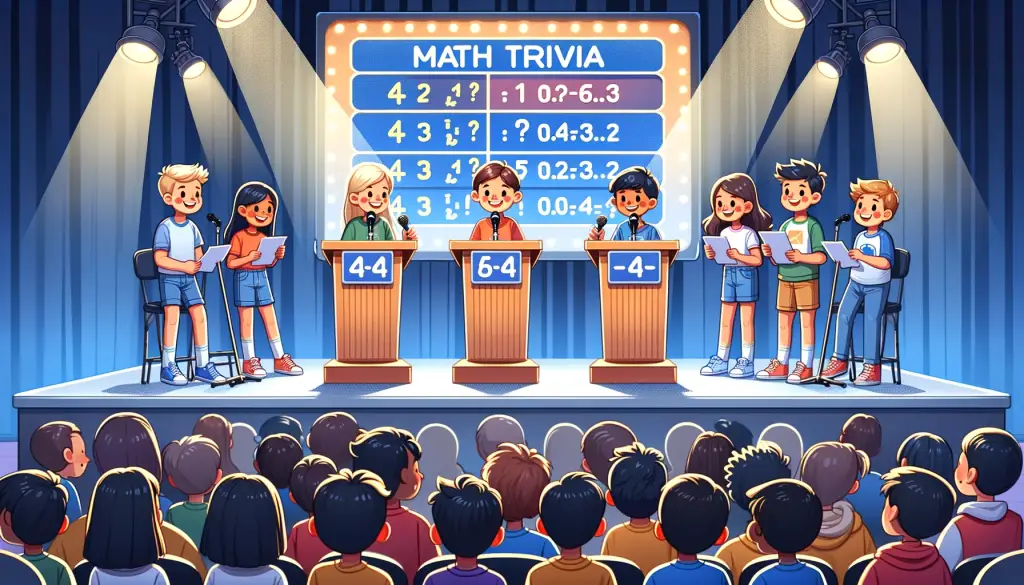
Middle school is a pivotal time for expanding mathematical knowledge, diving deeper into concepts like fractions, algebra, and geometry. This section is designed to challenge middle schoolers with trivia that touches upon basic algebraic concepts, theorems, and geometric shapes.
- Fractions and Operations:
- Question: “What is the term for the bottom number in a fraction, which indicates the total number of equal parts?”
- Answer: Denominator
This question not only tests understanding of fractions but also emphasizes their role in representing parts of a whole.
- Algebraic Concepts:
- Question: “What do you call a mathematical sentence that uses an equals sign to show that two expressions are equal?”
- Answer: An equation
Introducing algebraic terms such as ‘equation’ helps students understand the foundation of algebra.
- Geometry and Shapes:
- Question: “What is the term for a three-dimensional shape with two parallel, congruent circular bases?”
- Answer: Cylinder
Questions about geometric shapes like cylinders enhance spatial understanding and recognition skills.
- Exploring Theorems:
- Question: “In a right-angled triangle, which theorem states that the square of the hypotenuse is equal to the sum of the squares of the other two sides?”
- Answer: Pythagorean Theorem
Theorems like this are fundamental in geometry and encourage logical thinking.
- Understanding Algebraic Expressions:
- Question: “What is the value of x in the equation 3x + 7 = 16?”
- Answer: 3
Solving for x in simple algebraic equations helps build essential problem-solving skills.
- Basic Algebraic Operations:
- Question: “What operation would you perform first in the expression 4 + 3 x 2?”
- Answer: Multiplication (Following the order of operations, BEDMAS/BIDMAS)
Questions about order of operations reinforce the importance of following mathematical rules.
- Geometric Theorems and Properties:
- Question: “What is the term for a polygon with all sides and angles equal?”
- Answer: Regular Polygon
This introduces students to more complex geometric concepts and vocabulary.
These trivia questions for middle school math not only align with educational standards but also aim to make learning a fun and interactive experience. By combining fundamental concepts with interesting trivia, students are encouraged to explore and deepen their understanding of math, fostering a positive attitude towards learning and problem-solving.

Advanced Math Trivia for Budding Mathematicians
For older kids and those with a keen interest in advanced math, challenging trivia can provide an excellent way to deepen their understanding and spark further curiosity. This section delves into topics such as prime numbers, complex geometry, and number theory, presenting an opportunity for budding mathematicians to test and expand their knowledge.
- Prime Numbers and Patterns:
- Question: “What is the largest known prime number?”
- Answer: As of my last update, the largest known prime number is (2^{82,589,933} − 1), a Mersenne prime discovered in 2018. (Note: This may have changed if newer primes have been discovered.)
This question not only challenges their knowledge but also introduces them to the ongoing quest in mathematics to discover larger prime numbers.
- Complex Geometry Concepts:
- Question: “In complex geometry, what term describes a shape with only straight lines?”
- Answer: Polygon
Exploring complex geometry helps in understanding how basic shapes evolve into more advanced structures.
- Number Theory Exploration:
- Question: “What is the fundamental theorem of arithmetic?”
- Answer: It states that every integer greater than 1 is either a prime number or can be uniquely factorized into prime numbers.
This theorem is a cornerstone of number theory, illustrating the unique nature of prime numbers in the composition of integers.
- Advanced Algebraic Structures:
- Question: “What is a complex number?”
- Answer: A complex number is a number that can be expressed in the form a + bi, where a and b are real numbers, and i is the imaginary unit that satisfies the equation (i^2 = −1).
Complex numbers are essential in advanced mathematics, providing solutions to equations that have no real solutions.
- Exploring the Fibonacci Sequence:
- Question: “What is the only number that appears four times in the Fibonacci sequence?”
- Answer: 1 (The sequence starts 0, 1, 1, 2, 3, 5, 8, 13…)
The Fibonacci sequence is not just a series of numbers; it’s a gateway to understanding various mathematical concepts and their applications in nature and science.
- Intriguing Mathematical Concepts:
- Question: “What is the term for a solid shape with a polygon base and triangular faces that meet at a common point?”
- Answer: Pyramid
Questions like this encourage an interest in three-dimensional shapes and their properties, key in fields like architecture and engineering.
By engaging with these advanced math trivia questions, students are not just recalling facts; they are delving into the heart of mathematical theory and its real-world applications.
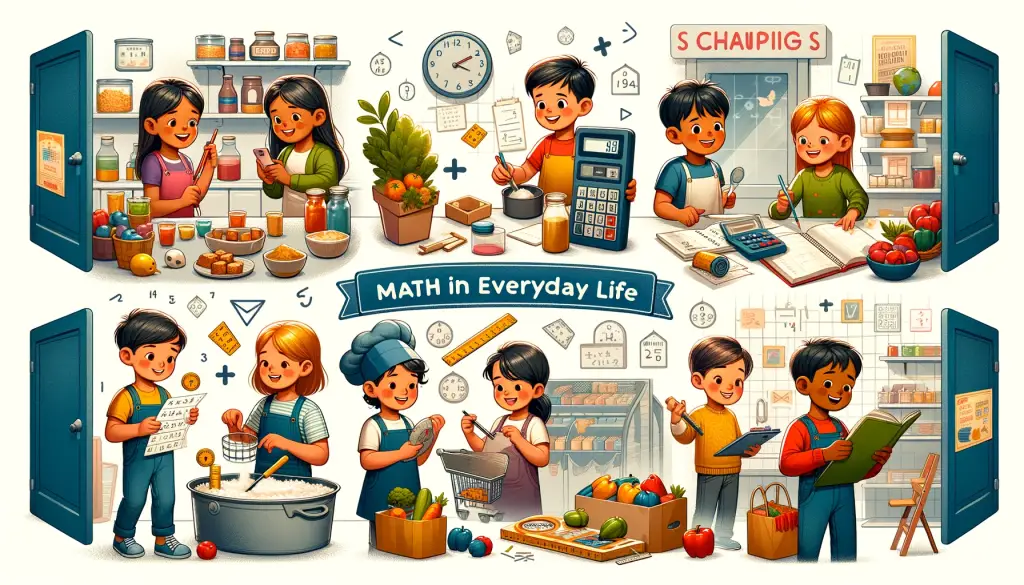
Math in Everyday Life
Math is not just confined to textbooks and classrooms; it’s an integral part of our daily lives. This section of the article connects math trivia to real-life situations and applications, focusing on measurements, time, and basic calculations that we encounter daily. These questions help illustrate the practical and often overlooked role of math in our everyday activities.
- Real-World Measurements:
- Question: “If you buy 3.5 meters of fabric to make curtains and each curtain needs 1.75 meters, how many curtains can you make?”
- Answer: 2 curtains
This question helps understand measurements and division in a practical context, such as sewing or purchasing materials.
- Time Calculation:
- Question: “Your bus leaves at 3:30 PM and it takes 45 minutes to reach your destination. What time will you arrive?”
- Answer: 4:15 PM
Calculating time is a fundamental skill, essential for planning and organizing daily activities.
- Everyday Math in the Kitchen:
- Question: “If a recipe calls for 2 cups of flour and you want to make half the recipe, how much flour do you need?”
- Answer: 1 cup
This question applies fractions in cooking, a common real-life application of math.
- Grocery Store Calculations:
- Question: “If an apple costs 50 cents and you buy 4 apples, how much do you spend in total?”
- Answer: $2.00
Simple multiplication and understanding of currency are key skills used in everyday shopping.
- Understanding Percentages:
- Question: “If a $50 shirt is on sale for 20% off, how much is the discount?”
- Answer: $10
This question introduces the concept of percentages, a common mathematical concept used in sales and finance.
- Calculating Perimeter and Area:
- Question: “If a garden is 10 feet long and 5 feet wide, what is its perimeter?”
- Answer: 30 feet
Questions like this help kids understand the concept of perimeter, which is relevant in tasks like fencing a yard or setting up a garden.
- Applying Math in Sports:
- Question: “If you run 4 laps of a 400-meter track, how much distance have you covered?”
- Answer: 1600 meters (or 1.6 kilometres)
This demonstrates how math is used in sports, for measuring distances or keeping track of scores.
These everyday math trivia questions emphasize the importance of math in daily life, making it more relatable and understandable. By connecting mathematical concepts to real-life scenarios.
Harnessing the Power of Math in the Real World
Mathematics is not just confined to the classroom; it’s a pivotal tool that shapes our understanding of the world. From calculating the trajectory of a rocket in the solar system to measuring ingredients for a perfect pumpkin pie, math is integral in diverse fields. Consider the Pythagorean theorem’s application in architecture or the Fibonacci sequence’s occurrence in the patterns of flower petals – these examples highlight how math is woven into the very fabric of life.
Engaging children in math-related activities, like a playful game at a grocery store where they calculate the cost of ice creams, not only enhances their mental math skills but also prepares them for real-world challenges. Even simple tasks, such as using a ruler to measure line segments or understanding the concept of an improper fraction, can be gateways to developing critical thinking skills. This application of math in everyday life fosters not just academic excellence but also practical wisdom.
Encouraging this exploration of math, whether through a fun math quiz or challenging math facts worksheets, can ignite a child’s curiosity and lead to significant cognitive development. It’s about turning every opportunity, every question, into a learning experience – a creative way to view the world through the lens of mathematics.
Also check out our list of 121 Science Trivia Questions For Kids
Exploring Math Beyond the Classroom
Mathematics is not just about numbers; it’s a universe of concepts touching everything from the human body to the farthest reaches of space. Let’s dive into some fun math trivia questions that showcase the diversity of this fascinating subject.
- The Human Body and Numbers:
- Trivia Question: “What is the total number of letters in the longest bone in the human body (the femur)?”
- Correct Answer: 5 letters This trivia introduces kids to anatomy, combining math with biology in an interesting way.
- Geometry in Nature:
- Trivia Question: “What natural structure has a convex shape resembling a dome?”
- Correct Answer: A beehive This illustrates geometry in nature, making the learning of shapes like convex structures more relatable.
- Space and Math:
- Trivia Question: “What is the largest planet in our solar system?”
- Correct Answer: Jupiter Such questions connect math to astronomy, sparking curiosity about the universe.
- Math in History:
- Trivia Question: “Who was the first person to propose the theory of relativity?”
- Correct Answer: Albert Einstein This introduces children to the historical aspects of math, showing how theories have evolved over time.
- Math in Everyday Objects:
- Trivia Question: “What common object used in the United States contains images of notable figures like Thomas Edison and is an example of paper money?”
- Correct Answer: The dollar bill This trivia brings attention to everyday uses of math, like currency and its design.
- Math in Awards:
- Trivia Question: “Which prestigious award, similar to a Nobel Prize, is given in the field of mathematics?”
- Correct Answer: Fields Medal This question highlights the recognition of excellence in mathematics.
- Math and the Cosmos:
- Trivia Question: “Which famous scientist discovered the law of universal gravitation?”
- Correct Answer: Isaac Newton This trivia bridges the gap between math and physics, showcasing how math helps us understand the laws of the universe.
Incorporating these trivia questions and facts into math quizzes can significantly enhance a child’s understanding and appreciation of mathematics. It shows that math is not just confined to textbooks but is a dynamic and integral part of our world.
Also Check Out
183 History Trivia Questions For Kids
Wrapping Up Math Trivia Questions For Kids
Math trivia is more than just a fun activity; it’s a valuable tool in the learning process. It transforms the sometimes abstract and challenging world of mathematics into an engaging and approachable subject. By incorporating math trivia into learning, children can explore mathematical concepts in a playful yet educational way. This approach not only enhances their problem-solving skills but also fosters a deeper appreciation and curiosity for the subject.
The beauty of math trivia lies in its versatility. It caters to various learning levels, from easy questions for young learners to more complex problems for older students and budding mathematicians. By connecting math to everyday life, trivia helps demystify math, showing its practical application in our daily activities. Interactive math games and trivia further enrich this experience, blending learning with fun and ensuring that mathematical concepts are absorbed more effectively and enjoyably.
As we conclude, it’s clear that math trivia is an invaluable component of modern education. It invites learners to explore the fascinating world of numbers, shapes, and equations in a relaxed and enjoyable environment. Whether it’s through solving interesting puzzles, exploring intriguing facts, or engaging in interactive games, math trivia makes learning an adventure.
So, we encourage you, our readers, to dive into the world of math trivia. Explore more, challenge yourself with different questions, and most importantly, enjoy the journey through the world of math. The exploration of mathematics is endless, and every trivia question answered is a step further in this exciting journey.

